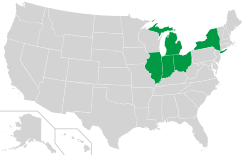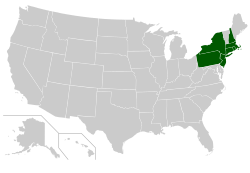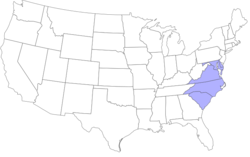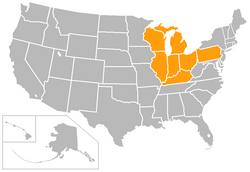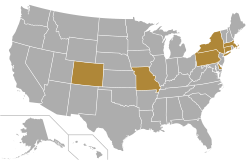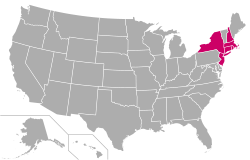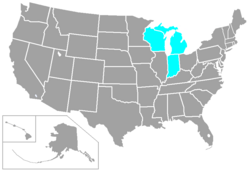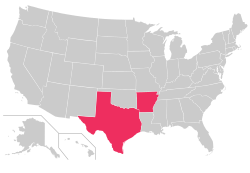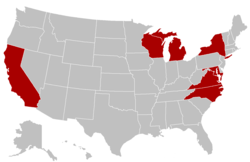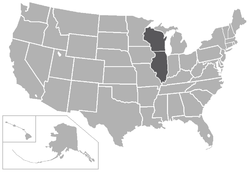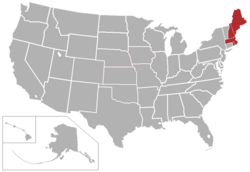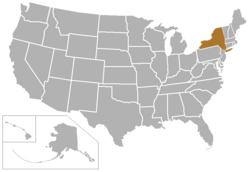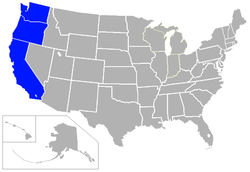Top Qs
Timeline
Chat
Perspective
List of NCAA conferences
From Wikipedia, the free encyclopedia
Remove ads
The National Collegiate Athletic Association (NCAA) is divided into three divisions based on scholarship allocation. Each division is made up of several conferences for regional league competition. Unless otherwise noted, changes in conference affiliation will occur on July 1 of the given year.
Division I
Summarize
Perspective
Under NCAA regulations, all Division I conferences defined as "multisport conferences" must meet the following criteria:[1]
- A total of at least seven active Division I members.
- Separate from the above, at least seven active Division I members that sponsor both men's and women's basketball.
- Sponsorship of at least 12 NCAA Division I sports.
- Minimum of six men's sports, with the following additional restrictions:
- Men's basketball is a mandatory sport, and at least seven members must sponsor that sport.
- Non-football conferences must sponsor at least two men's team sports other than basketball.
- At least six members must sponsor five men's sports other than basketball, including either football or two other team sports.
- Minimum of six women's sports, with the following additional restrictions:
- Women's basketball is a mandatory sport, with at least seven members sponsoring that sport.
- At least two other women's team sports must be sponsored.
- At least six members must sponsor five women's sports other than basketball, including two other team sports. If a conference officially sponsors an NCAA "emerging sport" for women (as of 2023, acrobatics & tumbling, equestrianism, rugby union, stunt, triathlon, or wrestling), that sport will be counted if five members (instead of six) sponsor it.
Schools in all divisions that sponsor athletic programs for only one sex/gender need only meet the sports sponsorship requirements for that sex/gender.[2]
Football Bowl Subdivision
Conferences in the Football Bowl Subdivision must meet a more stringent set of NCAA requirements than other conferences. Among these additional NCAA regulations, institutions in the Football Bowl Subdivision must be "multisport conferences" and participate in conference play in at least six men's and eight women's sports, including football, men's and women's basketball, and at least two other women's team sports. Each school may count one men's and one women's sport not sponsored by its primary conference toward the above limits, as long as that sport competes in another Division I conference. The men's and women's sports so counted need not be the same sport.[3][4]
- Known as Big East Conference prior to 2013. The American operates under the original 1979 Big East charter, but considers its competitive history to have started in 2013.
- 18 full members, 17 football members. Notre Dame football is an FBS independent, but has a substantial cross-scheduling agreement with the ACC.
- 10 members in 2026 with loss of UTEP and Louisiana Tech.
- Note that "independents" is not a conference; it is simply a designation used for schools whose football programs do not play in any conference. All of these schools have conference memberships for other sports.
- 12 members in 2026 with loss of Northern Illinois.
- 12 full members, 12 football members with Grand Canyon as a non-football member and Hawaii as a football-only affiliate.
- 11 full members, 9 football members in 2026 with the following changes:
- Loss of Boise State, Colorado State, Fresno State, San Diego State, and Utah State.
- Addition of Northern Illinois (football only), UC Davis (non-football), and UTEP (all sports).
- Upgrade of Hawaii's membership to all-sports.
- 11 full members, 9 football members in 2026 with the following changes:
- 20 sports in 2026 with addition of men's soccer and men's swimming & diving.
- Headquarters moving to Las Vegas, Nevada in July 2026.
- Pacific Coast Conference chartered in 1915; current charter formed 1959 by five former PCC members, with three others joining by 1964.
- 9 full members and 8 football members in 2026 with addition of Boise State, Colorado State, Fresno State, San Diego State, Texas State, and Utah State, plus Gonzaga as a non-football member.
- 19 sports upon resumption of full operation in 2026.
- Loses Texas State & gains Louisiana Tech in 2026
Football Championship Subdivision
In addition to competing in football, multisport conferences in the Football Championship Subdivision must still meet the general NCAA Division I requirements regarding the minimum number of men's and women's sports (see above).[1]
- 10 full members and 12 football members with Cal Poly and UC Davis as football-only affiliates.
- 11 confirmed full members and 13 likely football members in 2026 with departure of Sacramento State, plus addition of Southern Utah and Utah Tech.
- 9 full members and 2 football members.
- Both football members play in the OVC–Big South Football Association, an alliance between the Ohio Valley Conference and the Big South Conference which shares a single automatic berth in the FCS playoffs.
- While CAA Football was formally founded in 2007, its history can be traced back decades earlier.
- The earliest predecessor is the New England Conference, which existed from 1938–1947. However, CAA Football does not recognize this league as part of its history.
- In 1947, four New England Conference members joined with other schools to form the Yankee Conference under a new charter. CAA Football considers its history to have started with the Yankee Conference.
- The Yankee Conference, by then a football-only league, was taken over by the Atlantic 10 Conference after the 1996 football season.
- The all-sports CAA took over A-10 football in 2007, forming CAA Football as a separate entity.
- CAA Football is a separate entity from the multi-sports CAA.
- 13 members in 2026 with loss of Villanova and William & Mary, plus addition of Sacred Heart.
- Note that "Independents" is not a conference; it is simply a designation used for schools whose football programs do not play in any conference. These schools have conference memberships for other sports.
- 2 independents possible in 2026 with confirmed move of Sacred Heart to CAA Football and potential addition of Sacramento State.
- While the Ivy League considers its athletic conference to have been established in 1954, the history of the athletic league can be traced back decades earlier:
- In 1901, the Eastern Intercollegiate Basketball League (EIBL) was formed by five schools that would later become part of the current Ivy League; the EIBL membership eventually became identical to that of the future all-sports league. The EIBL was directly absorbed into the all-sports Ivy League, which considers the EIBL to be part of its history.
- In 1945, the Ivy Group Agreement, which governed competition and policies among the Ivy schools in football, was signed by all eight schools that eventually formed the all-sports league.
- The official formation of the athletic Ivy League came in 1954, when the Ivy Group Agreement was extended to cover all sports.
- Number of sports in which Ivy League championships are awarded, with the following caveats:
- Championships are awarded in the non-NCAA sports of men's rowing plus men's and women's squash.
- While championships are awarded in men's and women's ice hockey, no Ivy League tournaments are held. All Ivy ice hockey members compete in ECAC Hockey for that league's automatic NCAA tournament bids. Ivy champions are extrapolated from regular-season results of ECAC games that involve two Ivy teams.
- 8 full members, 6 football members.
- While the MVFC began football competition in 1985, the conference charter dates to 1982. See History of the Missouri Valley Football Conference for more details.
- 10 full members, 8 football members with Chicago State, Fairleigh Dickinson, and Le Moyne as non-football members and with Duquesne and Robert Morris as football-only affiliates.
- 9 full members, 8 football members likely in 2026 with confirmed loss of Saint Francis and expected addition of football by Chicago State.
- 11 full members, 7 football members (full member Morehead State plays football in the Pioneer Football League).
- 9 full members, 6 football members in 2026 with loss of Tennessee Tech and Little Rock.
- All current OVC football members (not counting Morehead State) play that sport in the OVC–Big South Football Association.
- 10 full members and 8 football members with Army, Navy, American, Boston, and Loyola (MD) as non-football members (Army and Navy both compete in FBS football) and with Fordham, Georgetown, and Richmond as football-only affiliates.
- 10 football members in 2026 with addition of Villanova and William & Mary as football affiliates.
- 10 full members, 9 football members.
- 11 full members, 10 football members in 2026 with addition of Tennessee Tech.
- 12 full members, 10 football members.
- Not an officially recognized NCAA conference; that body treats the UAC as the continuation of a preexisting football-only alliance between the Atlantic Sun Conference and Western Athletic Conference.
- Becomes an official NCAA conference in 2026 as a rebranded Western Athletic Conference.
- 9 full members, 7 football members in 2026 with the following changes:
- Addition of UT Arlington and Little Rock as full but non-football members.
- Loss of Southern Utah and Utah Tech.
- Number of sports in 2026 to be determined.
Non-football, multi-sport conferences
Multisport conferences that do not compete in football must still meet the general NCAA Division I requirements regarding the minimum number of men's and women's sports (see above).[1]
- 7 members in 2026 with loss of Austin Peay, Central Arkansas, Eastern Kentucky, North Alabama, and West Georgia.
- Although the charter of the current Big East dates only to the 2013 split of the original Big East, both the current Big East and the American Conference claim 1979 as their founding dates. The current Big East maintains the pre-split history of the original conference in all sports that it sponsors. Neither conference recognizes the history of the original Big East in football (currently sponsored by the American but not the present Big East) or rowing (formerly sponsored by the American and never sponsored by the current Big East).
- 22 NCAA-sanctioned sports, plus the non-NCAA and fully coeducational esports.
- 12 members in 2026 with loss of Hawaiʻi and UC Davis, plus addition of California Baptist, Sacramento State, and Utah Valley.
- 11 members in 2027 with loss of UC San Diego.
- The CAA Football Conference is a separate entity from the all-sports CAA.
- 12 members in 2026 with return of Northern Illinois.
- 23 NCAA-sanctioned sports plus two non-NCAA sports—men's rowing, and esports, which are fully coeducational.
- No more than 14 schools are competing in any one of the MPSF's sports in 2025–26.
- 62 members in 2026 with loss of California Baptist and Southern Utah.
- Sponsors 14 fully recognized NCAA sports (two of which feature only Division II members) and 2 non-NCAA sports (artistic swimming and men's rowing).
- Rebranding as the United Athletic Conference in 2026.
- 8 members under the United Athletic Conference banner in 2026 with the following changes:
- Addition of Austin Peay, Central Arkansas, Eastern Kentucky, North Alabama, and West Georgia.
- Loss of California Baptist, Southern Utah, Utah Tech, and Utah Valley.
Ice hockey conferences
Division I ice hockey has a different conference structure than the above multisport conferences. These schools have memberships in other conferences for other sports.
- The Atlantic Hockey Association and College Hockey America merged in 2024 to form Atlantic Hockey America. Atlantic Hockey was founded (as the MAAC) in 1997 and the CHA in 1999.
- Founded in 2020, with play starting in 2021, as the revival of an earlier CCHA that existed from 1971 to 2013; the current CCHA considers itself a continuation of the original. Bowling Green, which was a member of the original CCHA for its entire existence and is a charter member of the revived conference, maintained rights to the league name.
- 8 members in 2026 with loss of St. Thomas.
- 6 independents in 2026 with addition of Tennessee State.
- Established as a scheduling alliance in 2017, officially organized as a conference in 2018, and officially recognized by the NCAA in 2019.
- Although founded in 2011, the NCHC did not begin play until 2013.
- 10 members in 2026 with addition of St. Thomas.
- Founded in 1951 as a men's-only conference; women's play began in 1999. The men's side of the WCHA folded after the 2020–21 season, with most of its members forming the revived CCHA.
Other single-sport conferences
This list includes conferences in sports that the NCAA does not fully split into divisions, such as men's volleyball and rifle. Sports in which the NCAA sponsors separate championships for men and women are officially treated by the NCAA as two separate sports.
- There are 7 NCAA varsity members; the conference also has one junior college member.
- 9 schools have both men's & women's varsity teams, 9 have men's varsity teams only, 8 have women's varsity teams only; additionally, there are 136 men's and 86 women's club teams.
- Women only. The GCC was founded in 2013 as a women's-only conference; a men's division was added in 2016 and shut down in 2023.
- There are 2 varsity members; the conference also has 7 college club members.
- There are 8 varsity members; the conference also has 7 college club members.
- There are 7 varsity members; the conference also has 6 college club members.
- There are 6 varsity members; the conference also has 13 college club members.
- There are 10 varsity members; the conference also has 10 college club members.
- There are 8 varsity members; the conference also has 13 college club members.
- There are 8 varsity members; the conference also has 5 college club members.
- There are 6 varsity members; the conference also has 4 college club members.
Remove ads
Division II
Summarize
Perspective
Among the NCAA regulations, Division II institutions have to sponsor at least five sports for men and five for women (or four for men and six for women), with two team sports for each sex, and each playing season represented by each sex. Teams that consist of both men and women are counted as men's teams for sports sponsorship purposes.[5]
Current conferences
Conferences that sponsor football are highlighted in yellow.
- 13 members in 2026 with addition of Fresno Pacific.
- 13 full members; 12 football members.
- 16 full members, 7 football members.
- 25 NCAA sports plus women's flag football, currently non-NCAA but expected to become part of the NCAA Emerging Sports for Women program in 2026–27.
- 11 full members, 8 football members.
- 15 full members, 9 football members.
- 13 full members, 10 football members.
- 12 full members, 4 football members.
- 5 all-sports independents (non-football), plus one football independent (Northeastern State)
- 18 full members, 10 football members with Central Washington and Western Oregon as football-only affiliates.
- 19 full members, 11 football members in no later than 2027 with addition of Texas A&M–Texarkana.
- 14 full members, 10 football members with Northeastern State competing as a D-II Independent in football.
- 11 full members, 9 football members.
- 12 full members, 9 football members in 2026 with addition of Shawnee State.
- 16 full members, 14 football members.
- 13 members in 2026 with loss of Azusa Pacific.
- 17 full members, 15 football members.
- 18 full members, 16 football members in 2026 with addition of Lackawanna.
- 15 full members, 10 football members.
- 12 full members, 10 football members.
- 15 full members, 13 football members.
Single-sport conferences
Other sports
These all-sports conferences sponsor sports which do not have D-II championships.
- Number reflects membership in the sport that lacks a D-II championship, not the number of full members.
- Expected to become part of the NCAA Emerging Sports for Women program no later than 2026–27.
- Part of the NCAA Emerging Sports for Women program; expected to become an official NCAA championship sport in 2026–27.
Remove ads
Division III
Summarize
Perspective
Unlike the other two divisions, Division III institutions cannot offer athletic scholarships. Among the other NCAA Division III requirements, schools have sports sponsorship requirements set by the NCAA. All institutions, regardless of enrollment, must sponsor at least three team sports for each sex/gender, and each playing season represented by each sex/gender.[6]
A sports sponsorship rule unique to Division III is that the total number of sports that must be sponsored differs by a school's full-time undergraduate enrollment. Schools with an enrollment of 1,000 or fewer must sponsor at least five sports for men and five for women; those with larger enrollments must sponsor six men's and six women's sports. As in the other divisions, teams that include both men and women are treated as men's sports for the purpose of these regulations.[7]
Current conferences
Conferences that sponsor football highlighted in yellow.
- 8 members in 2026 with loss of Alfred State.
- 4 full members.
- 6 full members in 2026 with addition of Schreiner and McMurry.
- 20 NCAA sports plus women's flag football, currently a non-NCAA sport but expected to become part of the NCAA Emerging Sports for Women program no later than 2026–27.
- 11 full members, 7 football members.
- Plans to adopt a new name in 2027.
- 9 members in 2027 with addition of New Jersey City.
- 8 full members in 2026 with addition of Alverno.
- 9 full members, 10 football members with Washington (MO) as a football-only affiliate.
- 9 football members in 2026 with loss of Washington (MO).
- 10 full members, 10 football members in 2027 with addition of Concordia (WI).
- 7 full members in 2026 with loss of Maryville and Wesleyan (GA).
- 11 members, 8 football members with Maine Maritime and New England College as football-only affiliates.
- 12 full members with Elmira, Houghton, Keuka, Nazareth, Russell Sage, SUNY Geneseo, and SUNY Poly as non-football members; 8 football members with Hilbert, SUNY Cortland, and SUNY Morrisville as football-only affiliates.
- 10 full members, 7 football members.
- 2 all-sports independents (non-football), 0 football independent (which are members of non-football conferences).
- 10 members with Drew, Elizabethtown, Goucher, and Scranton as non-football members and 7 football with Keystone as a football-only affiliate.
- 12 full members, 7 football members with Buffalo State as a football-only affiliate.
- 9 full members with MCLA and Salem State as non-football members, 11 football members with Anna Maria, Castleton, Plymouth State, UMass Dartmouth, and Western Connecticut as football affiliates.
- 9 full members, 8 football members.
- The MAC is actually an umbrella organization of three conferences. Eight schools are members of the MAC Commonwealth and eight others are members of the MAC Freedom. Each league conducts competition in the same set of 14 sports, not including football. The third league, called the Middle Atlantic Conference, combines schools from the MAC Commonwealth and MAC Freedom for 13 other sports, including football.
- 16 full members (8 Commonwealth, 8 Freedom) and 10 football members.
- 18 full members in 2026 (9 Commonwealth, 9 Freedom) with addition of non-football Marywood (Freedom) and Neumann (Commonwealth).
- 13 full members, 10 football members.
- 11 full members, 10 football members.
- 12 full members and 8 football members.
- 10 full members with New Jersey City, Ramapo, Rutgers–Camden, Rutgers–Newark, and Stockton as non-football members; 7 football members with Christopher Newport and Salisbury as football affiliates.
- 11 full members in 2026 with addition of SUNY New Paltz.
- 10 full members in 2027 with loss of New Jersey City.
- 8 full members in 2026 with loss of SUNY Cobleskill and SUNY Delhi.
- 10 football members in 2026 with addition of Washington (MO).
- 14 full members, 9 football members with Eureka as a football-only affiliate.
- 13 full members, 9 football members in 2026 with loss of non-football Alverno.
- 12 full members, 8 football members in 2027 with loss of Concordia (WI).
- 13 full members, 9 football members in 2026 with loss of non-football Alverno.
- 9 full members, 8 football members.
- 12 full members, 12 football members, with two full members not sponsoring football (Chatham and Franciscan) and two football affiliates (Carnegie Mellon and Case Western Reserve).
- 13 full members and 13 football members in 2026 with addition of Saint Francis.
- 8 full members, 8 football members with one full member not sponsoring football (Oglethorpe).
- 9 full members and 9 football members in 2026 with addition of Maryville.
- 9 full members, 6 football members.
- 10 full members, 8 football members in 2026 with addition of Azusa Pacific and reinstatement of football by full member Whittier.
- 11 full members, 5 football members with football-only affiliate Lyon.
- 10 full members, 5 football members in 2026 with loss of Schreiner and McMurry.
- 12 full members in 2026 with loss of SUNY New Paltz and promotion of associate members Alfred State, SUNY Cobleskill, and SUNY Delhi.
- 8 full members with Bethany Lutheran, North Central, Northland, and Wisconsin–Superior as non-football members; 6 football members with Greenville, and Westminster (MO) as football-only affiliates.
- 10 full members with Mary Baldwin, Meredith, Pfeiffer, Salem College, and William Peace as non-football members; 9 football members with Belhaven, Huntingdon, LaGrange, and Maryville as football-affiliates.
Single-sport conferences
Other sports
These all-sports conferences sponsor sports which do not have D-III championships.
- Number reflects membership in the sport that lacks a D-III championship, not the total conference membership.
- 7 or 8 women's wrestling members in 2026. Full member Coe will add the sport. Another full member, Luther (IA), will leave for the Midwest Conference, but since that conference does not sponsor women's wrestling, Luther may remain an A-R-C associate.
Remove ads
Defunct NCAA conferences
Summarize
Perspective
- * - Operated before the NCAA split into divisions in 1955.
In addition to the above, two single-sport conferences that currently participate in NCAA National Collegiate sports (those whose championship events are open to members of more than one NCAA division) and previously operated both men's and women's divisions now operate as women-only leagues.
Remove ads
See also
References
Wikiwand - on
Seamless Wikipedia browsing. On steroids.
Remove ads






